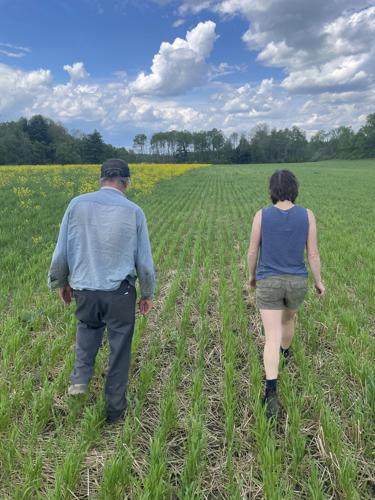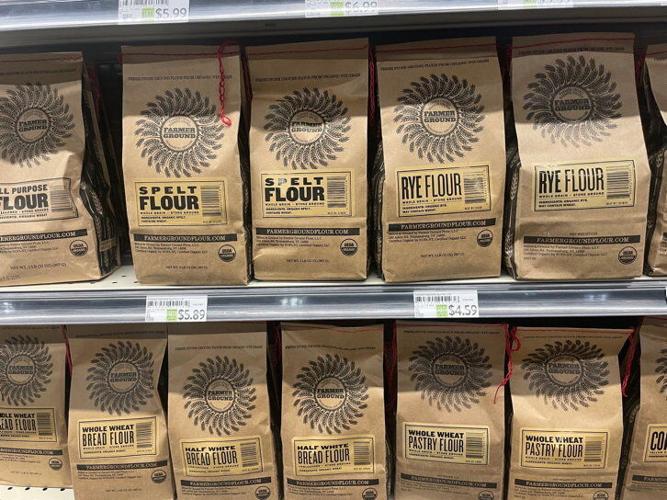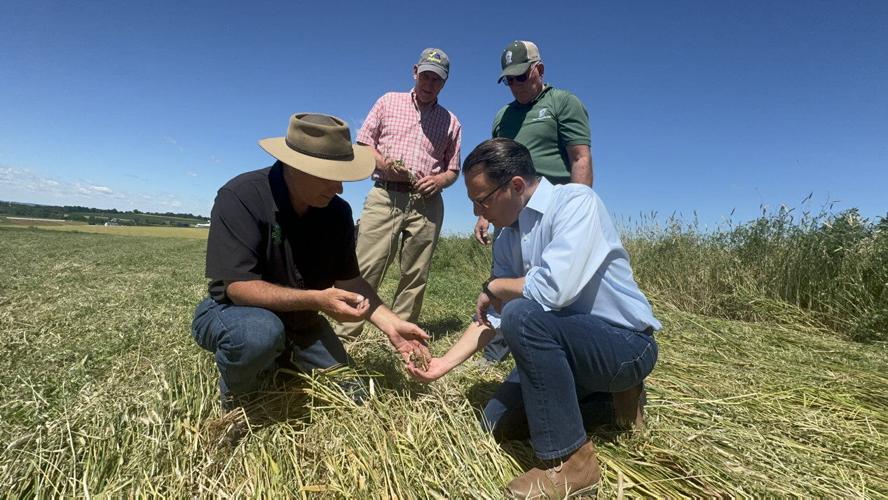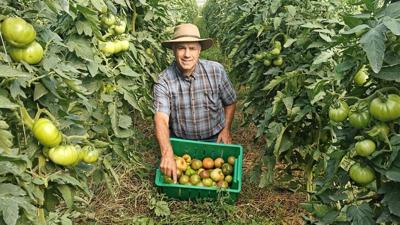“Regenerate” means to create anew or restore, and it’s a word that’s been around since the 14th century.
It’s gotten renewed attention in recent years as it’s become the new buzzword for agriculture that is supposedly friendly to the environment.
But as farmers and food companies have rushed to cash in on the term, the practices that qualify as regenerative have become a matter of debate.
Some farmers seek to be regenerative by being more rigorous than organic standards, while others take conventional no-till as their starting point.
Publisher Robert Rodale, whose father is credited with launching the organic movement in the U.S., paired the term “regenerative” with agriculture over 30 years ago.
In a 1989 USDA interview, he said he preferred the term regenerative over sustainable, another contested term that has become vogue in agriculture.
Rodale argued that sustainability appeals to policymakers and scientists because it seems understandable.
But regenerative ag isn’t about maintaining the status quo.
“I don’t think the average person aspires to live in a sustained environment,” Rodale said. “They want to live in something that’s expanding and doing better.”
Rodale traced the concept of sustainable ag back to a speech by Abraham Lincoln at the Wisconsin State Fair in 1859, a year before he was elected president.
“He warned in Milwaukee that a fully mechanized agriculture, a big farm based on machinery, could not sustain itself,” Rodale said.

New York organic grain farmer Thor Oechsner and a Cornell University field tech walk a plot of spring wheat that was no-till planted into a mat of winter-killed oat and pea residue.
Rodale, who died in 1990, credited his elder contemporary, British organic farmer Lady Eve Balfour, with bringing sustainability into the modern agricultural lexicon.
“Lady Balfour, in about ’78, started using the term sustainable agriculture to make organic farming sound better,” Rodale told the interviewer with a chuckle.
In the late 1970s into the early 1980s, Rodale said, farmers and scientists began working in earnest on lower-input agriculture based on replicating biological systems.
Rodale appeared to make more of a distinction between high-input farming systems and lower-input systems that considered environmental and social management than he did between organic and non-organic systems.
Two years before that interview, the Rodale Institute’s Regenerative Agricultural Association had published “How to Make $100,000 Farming 25 Acres,” by Booker T. Whatley, a professor at Tuskegee University, a historically Black land-grant university.
Whatley’s famous predecessor at Tuskegee, George Washington Carver, is considered in some circles to be the father of regenerative agriculture, though he did not coin the term.
To improve soils depleted by years of cotton production, Carver did pioneering work on crop rotations that included legumes such as peanuts, soybeans and cowpeas.
To help poor Black farmers who did not have ready access to financing, Whatley built on Carver’s concepts of low-input agriculture.
Whatley promoted marketing innovations like you-pick and “clientele membership clubs,” prepaid boxes of crops that informed today’s CSAs.
New Labels in Town
As regenerative became the new buzzword in agriculture, major companies such as PepsiCo and Bayer began using the term in marketing material.
Earlier this year, New York Attorney General Letitia James filed a lawsuit against two U.S. divisions of JBS, the world’s largest meatpacker, alleging the company made false claims about its regenerative farming reducing greenhouse gas emissions.
James called the claims greenwashing, or deceptive representations of environmental friendliness.
As the organic food sector has matured — U.S. retail sales topped $60 billion in 2022 — some who helped establish the national organic standards 20 to 30 years ago say the expansion has come at a cost.
In their view, the federal organic label has lost its initial intent of encouraging ethical farming practices and environmental stewardship.
Regenerative certification, although not backed by USDA (or any other government agency), is positioned as a way to refocus on those values.
One of the big certifying organizations is Regenerative Organic Certified.
It was created in 2017 when Patagonia, Dr. Bronner’s and the Rodale Institute formed the Regenerative Organic Alliance.
Besides a baseline requirement that farmers be certified under the National Organic Program, applicants must meet additional rubrics related to soil health, animal welfare and social fairness, such as paying workers a living wage.
“Regenerative organic was clearly started by the organic purist community who was disappointed that the organic label doesn’t include some of the more important parts of what has been the organic food movement,” said George Siemon, a former CEO and a founding farmer at Organic Valley. “So they took the organic label and added onto it things like animal welfare, concerns with social justice, and made one label. That makes a lot of sense in a lot of ways.”
For one, he said, regenerative certification helps companies such as Whole Foods differentiate themselves in the marketplace from price-setting behemoths like Walmart and Costco.
That hasn’t been as simple as it sounds.
“Unfortunately, the word regenerative is being used at the same time by conventional ag,” Siemon said. “It’s very debatable that this isn’t just a big mess now.”
Elizabeth Whitlow, the executive director of the Regenerative Organic Alliance, said organic has plateaued, and it’s time to raise the bar for customers who want more transparency.
Her organization certifies farmers and licenses the label.
“The brands don’t really get certified, but they have to show us their whole supply chain,” said Whitlow, who has worked in the organic farming sector for more than 20 years. “They have to be super transparent, open their books, show us that they’re paying the farmers a premium.”
Thor Oechsner is one of the farmers seeking Regenerative Organic Certified credentials.
He farms 1,000 acres in upstate New York and is part owner of a mill that sells 2-pound bags of artisan flour to Whole Foods and Wegmans.
“Our buyers want us to be ROC certified,” Oechsner said. “I’m sort of the guinea pig in the group of farmers that grows for the mill. I’m the ROC-certified guinea pig.”
Oechsner, who has worked on his own and with Cornell University to implement sustainable farming practices over the decades he’s been farming, is nonplussed.
“I don’t know that we’re going to have to change that much,” he said. “And some of it’s good. I have to keep a tillage log, and then every time I do it, I have to justify it.”

Wegman’s and Whole Foods are requiring that Farmer Ground Flour, and the mill’s growers, become Regenerative Organic Certified.
Regenerative Organic Certified is designed not to be duplicative with other certifications.
For example, the program focuses on farming practices because handling facilities are already covered adequately by the required organic certification, Whitlow said.
Even so, ROC has had to make judgment calls.
The program initially planned for no-till to be part of its top-tier certification (it has bronze, silver and gold levels). But after much debate, organizers backed conservation tillage instead.
ROC works with 14 organic certifiers across the globe.
“It’s much better for us to lean on the accredited organic certifiers, and they do the audit as an add-on,” Whitlow said.
That strategy has extended the reach of the program.
“If we didn’t work with them, we would not be able to get into the remote hills of Sierra Leone or India,” she said.
No Tillin’
Steve Groff, a farmer in Lancaster County, Pennsylvania, has long used the word “regenerative” to describe his agricultural practices at Cedar Meadow Farm.
Recently, he decided to get certified by Regenified, which doesn’t require farms to be organic.
“Regenerative doesn’t necessarily mean organic, and organic doesn’t necessarily mean regenerative,” Groff said.
Groff, well-known for his no-till farming methods, said he has reached Tier 5, the highest certification level.
“What I like about the regenerative type of certifications is they generally require improvement over time for soil health and how that impacts human health,” he said.

Regenerative hemp farmer Steve Groff gives Pennsylvania governor Josh Shapiro a handful of soil to demonstrate how cover crops lock in moisture and carbon.
Regenified requires that a farmer advance to a higher level within three years.
Groff said he often gets asked to explain the difference between regenerative and organic agriculture. In June the question came from Pennsylvania Gov. Josh Shapiro, who visited his farm.
To Groff, regenerative ag is outcome-based, while organic farming is process-based.
Under the National Organic Program, farmers must meet a checklist of do’s and don’ts.
But in his regenerative ag certification, farmers earn points in 65 parameters, like the percentage of fields covered by living plants, the percentage of days with living roots in the ground, and the number of birds observed on the property.
Besides having a two-decade history with the guy — soil health pioneer Gabe Brown — who launched Regenified, Groff said he appreciates the flexibility to develop the practices that work best on his farm.
“I’m 100% no-till including my high tunnels,” he said. “And I grow cover crops and living cover ... and I don’t use any plastic.”
Other regenerative certification programs include Certified Regenerative by A Greener World and the Savory Institute’s Land to Market.
For Whitlow at the Regenerative Organic Alliance, regenerative agriculture, and a system to hold those who use the term accountable, is all about lessons learned.
“A lot of organic farmers that I used to visit as an inspector were also regenerative,” she said. “And they were practicing a lot of these core principles that are written into the Organic Food Production Act but not necessarily in practice in the law.”
Watch a Video of Steve Groff explaining regenerative farming to Pennsylvania governor Josh Shapiro:
Pennsylvania Governor Josh Shapiro talks to Lancaster County regenerative hemp farmer Steve Groff about no-till farming.







